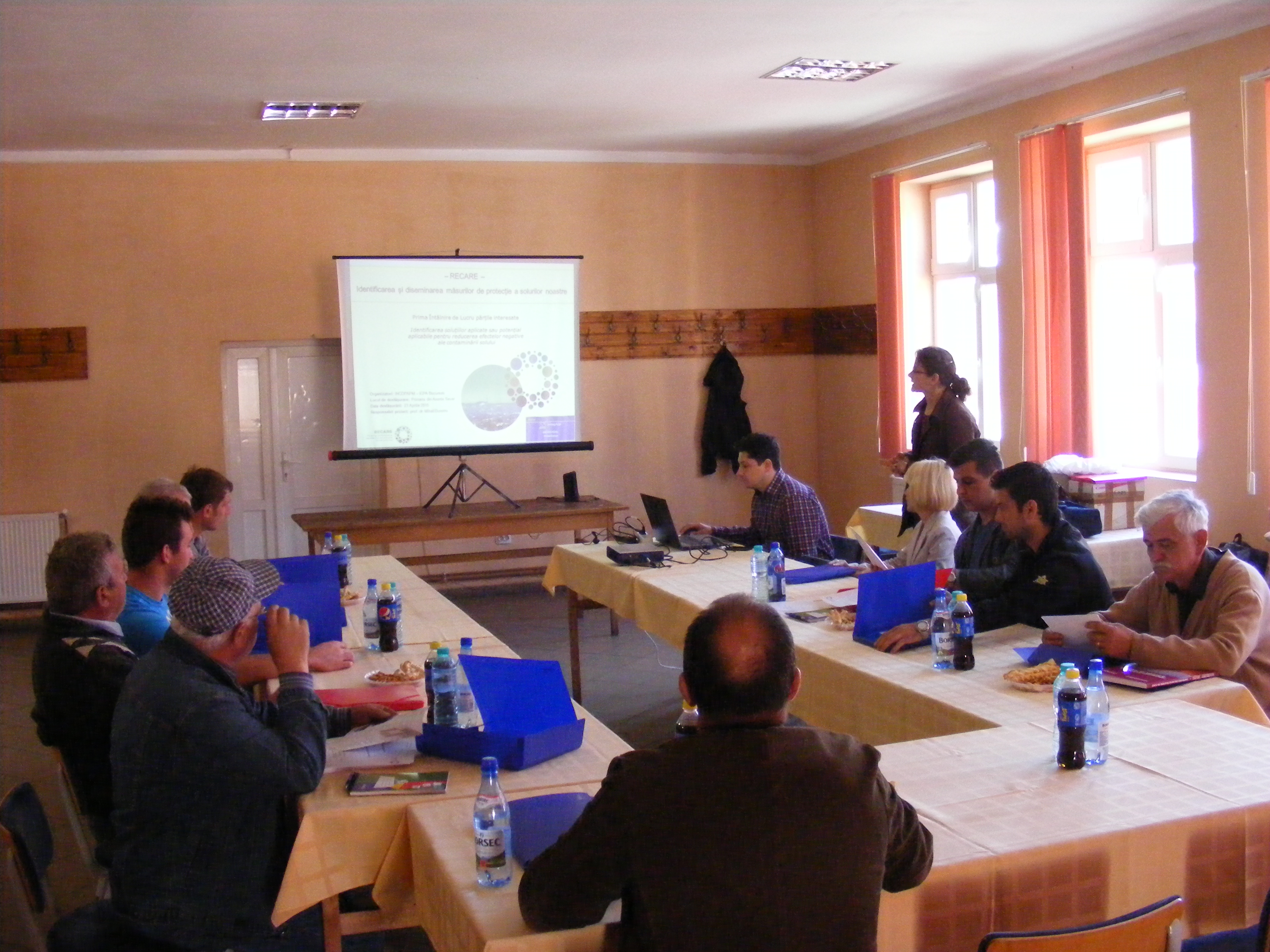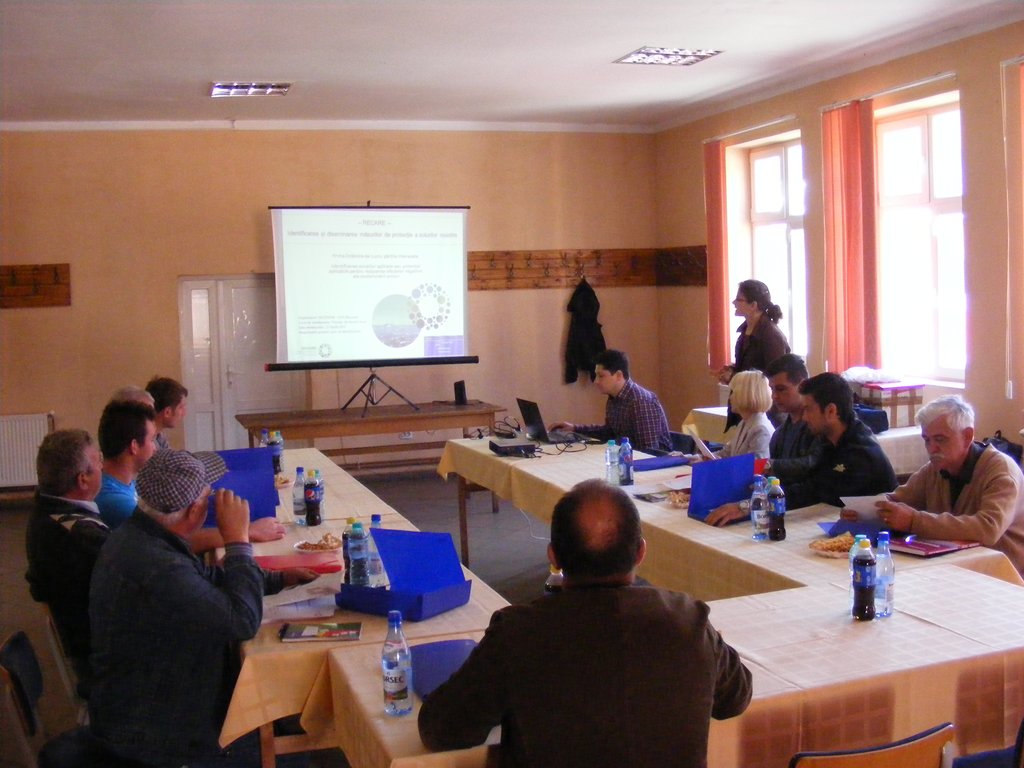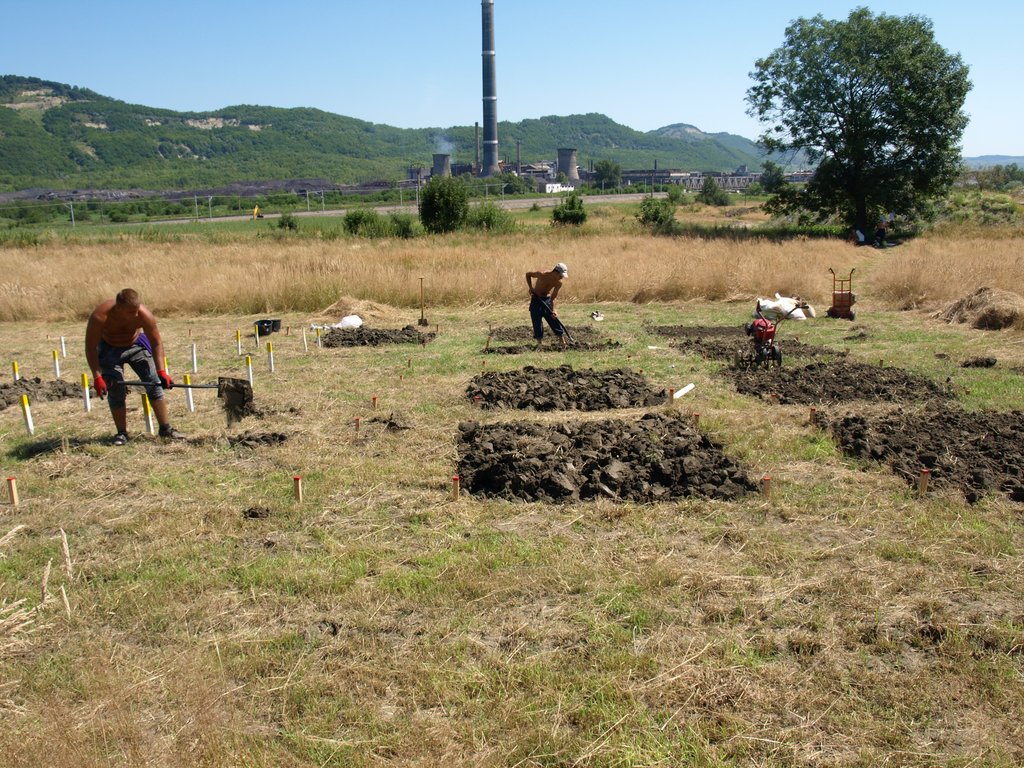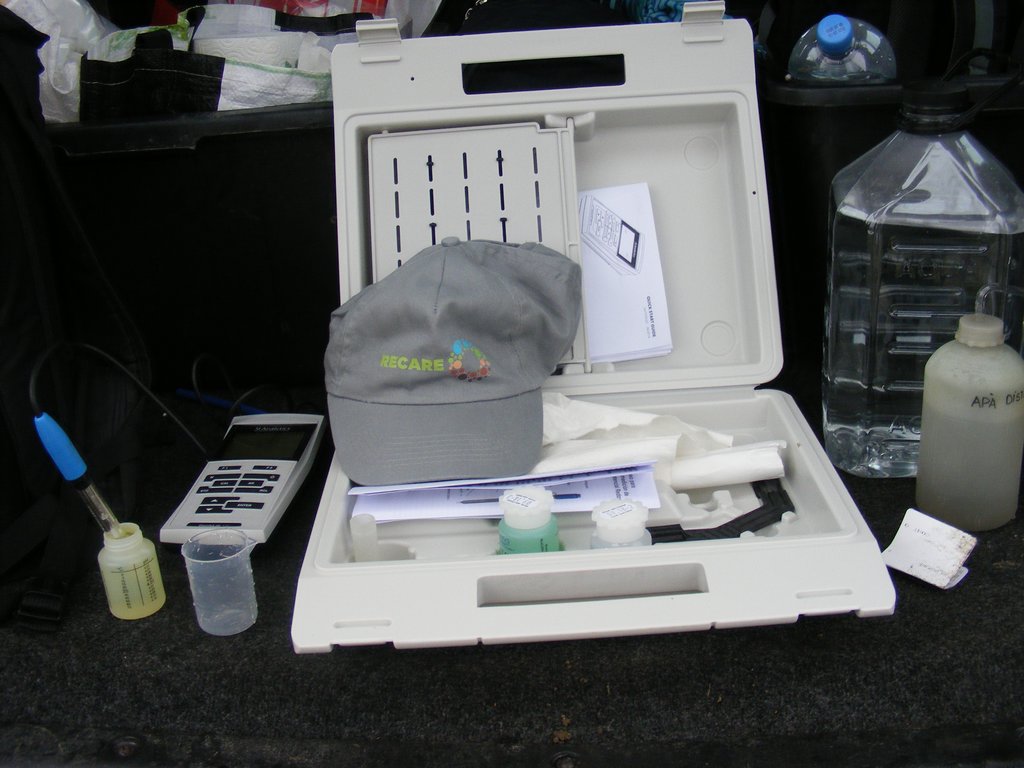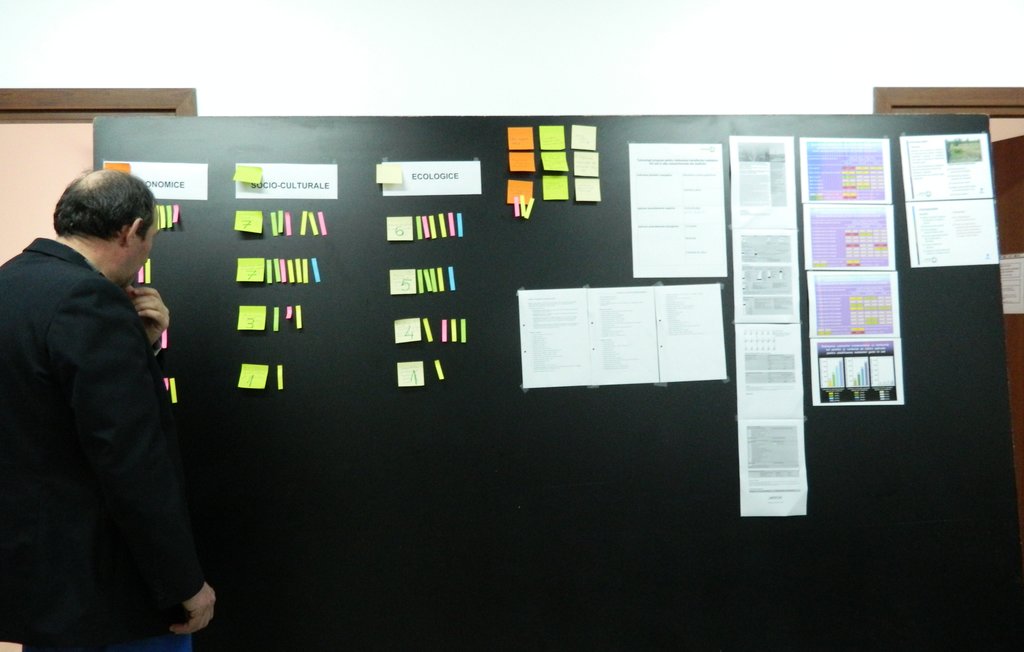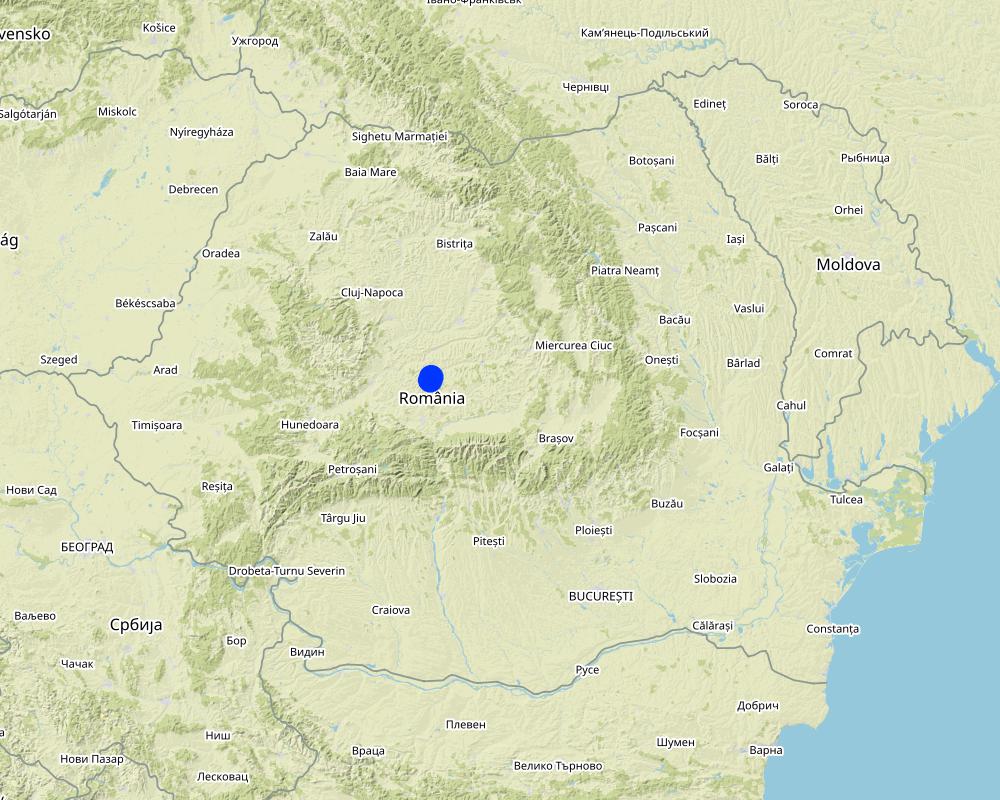Information and awareness raising for safe use of metal contaminated land [โรมาเนีย]
- ผู้สร้างสรรค์:
- การอัพเดท:
- ผู้รวบรวม: Nicoleta Vrinceanu
- ผู้เรียบเรียง: –
- ผู้ตรวจสอบ: GWJ van Lynden, Joana Eichenberger
Cresterea gradului de constientizare si informarea populatiei in scopul utilizarii in siguranta a terenurilor din zonele contaminate cu metale grele
approaches_570 - โรมาเนีย
ดูส่วนย่อย
ขยายทั้งหมด ย่อทั้งหมด1. ข้อมูลทั่วไป
1.2 รายละเอียดที่ติดต่อได้ของผู้รวบรวมและองค์กรที่เกี่ยวข้องในการประเมินและการจัดเตรียมทำเอกสารของแนวทาง
1.3 เงื่อนไขที่เกี่ยวข้องกับการใช้ข้อมูลที่ได้บันทึกไว้ผ่านทาง WOCAT
วันที่เก็บรวบรวมข้อมูล (ภาคสนาม):
02/03/2015
ผู้รวบรวมและวิทยากรหลักยอมรับเงื่อนไขเกี่ยวกับการใช้ข้อมูลที่ถูกบันทึกผ่านทาง WOCAT:
ใช่
2. คำอธิบายของแนวทาง SLM
2.1 การอธิบายแบบสั้น ๆ ของแนวทาง
The aim of this Aprroach is to increase the awareness about the risk related to agricultural use of contaminated land and to present the appropriate technologies for sustainable use of contaminated land in order to reduce the transfer of contaminants into the food chain. The implementation of appropriate SLM will improve the soil and crop quality with positive effects on the quality of life for local community from contaminated area.
2.2 การอธิบายอย่างละเอียดของแนวทาง
การอธิบายอย่างละเอียดของแนวทาง:
The Case Study area is located in Sibiu County, around the most important factory for processing of non-ferrous ores – Copsa Mica. The main environmental damages in the area Copşa Mică (Romania) are caused by ore processing and this town was classified as an environmental disaster area. The main pollutants identified in this area were cadmium, copper, lead and zinc. According to data from LPIS provided by Sibiu County Center of Agency for Payments and Intervention in Agriculture (2012) the arable land represents 60.4% from total area (2818.6ha) being located mainly in bottomland. Grassland represents 34.9% from total area, that means 1627.3 ha. Orchards and vineyards represent a very small proportion from total cultivated area, only 2.3% (106 ha) and 2.4% (110.3 ha).
Large scale migration from urban to rural areas (village surrounding the Copsa Mica) took place after reducing the activities of industrial platform. In villages located in polluted area there are many small landowners. The lands are used as agricultural land and the products are used for own consumption. Also, due to both, low fertility of soil (as a result of contamination) and lack of financial resources, there are lands abandoned. The agricultural use of the land represents a risk for population health and also reduces the number of methods that could be used for remediation.
The aim of the approach was to increase the awareness about the risk related to agricultural use of contaminated land and to present the appropriate technologies for sustainable use of contaminated land in order to reduce the transfer of contaminants into the food chain. The implementation of appropriate SLM will improve the soil and crop quality with positive effects on the quality of life for local community from contaminated area.
During workshops stakeholders are informed about state of soil degradation from their area, about risk related to agricultural use of contaminated land. The researchers and SLM experts share their experience with land owners and land users related to sustainable measures for reducing the effects of soil contamination and together they select the measures to be tested. The production of biomass for non-food purpose has been tested as a potential solution to produce valuable biomass while remediating the soil. Immobilization of heavy metals in soil was agreed by the traditional land owners who want to keep the agricultural use for their land.
Land owners offer the plot for testing the new technology and researchers / SLM experts organised experimental field and presenting the results to land owners, local authority, farmers, students during information session (field day, workshop)
2.3 รูปภาพของแนวทาง
ข้อสังเกตทั่วไปเกี่ยวกับรูปภาพ:
Activities for information and test the new technology selected by land users and experts
2.5 ประเทศ ภูมิภาค หรือสถานที่ตั้งที่ได้นำแนวทางไปใช้
ประเทศ:
โรมาเนีย
ภูมิภาค/รัฐ/จังหวัด: :
Sibiu county
ข้อมูลเฉพาะเพิ่มเติมของสถานที่ตั้ง:
Copsa Mica
ความคิดเห็น:
Both Copsa Mica and Axente Sever are located in highly contaminated area.
Map
×2.6 วันที่เริ่มต้นและสิ้นสุดของแนวทาง
ถ้าไม่รู้ปีที่แน่นอนให้ประมาณวันที่ที่ริเริ่มใช้แนวทางนี้ :
น้อยกว่า 10 ปี (เร็วๆนี้)
2.7 ประเภทของแนวทาง
- ใช้โครงงานหรือแผนงานเป็นฐาน
2.8 เป้าหมายหรือวัตถุประสงค์หลักของแนวทาง
The aim was to increase the awareness about the risk related to agricultural use of contaminated land and to present the appropriate technologies for sustainable use of contaminated land in order to reduce the transfer of contaminants into the food chain. The implementation of appropriate SLM will improve the soil and crop quality with positive effects on the quality of life for local community from contaminated area.
2.9 เงื่อนไขที่เอื้ออำนวยหรือเป็นอุปสรรคต่อการนำเทคโนโลยีภายใต้แนวทางนี้ไปปฏิบัติใช้
บรรทัดฐานและค่านิยมทางสังคม วัฒนธรรม ศาสนา
- เป็นอุปสรรค
The traditional farmers want to preserve the agricultural use of land (crop production and grazing). Growing biofuel crops would require changing the land use for a long period of time.
การมีไว้ให้หรือการเข้าถึงแหล่งการเงินและบริการ
- เป็นอุปสรรค
Lack of financial resources of the land users. The financial inputs for implementation are considered high even if there are subsidies for energy crops.
การจัดตั้งระดับองค์กร
- เป็นอุปสรรค
There are no interest for SLM on contaminated lands
กรอบแนวทางในการดำเนินการด้านกฎหมาย (การถือครองที่ดิน สิทธิในการใช้ที่ดินและน้ำ)
- เป็นอุปสรรค
Due to the large number of owners and the division of the land into small plots there are difficulties with respect to the application of appropriate SLM.
นโยบาย
- เป็นอุปสรรค
Although there are legal frameworks regarding pollution control there are no institutions responsible for the development and implementation of remediation measures. Also there are no clear legal descriptions of decision criteria for choosing the appropriate remediation actions.
ความรู้เกี่ยวกับ SLM การเข้าถึงการสนับสนุนด้านเทคนิค
- เป็นอุปสรรค
Although there are known risks associated with soil contamination with heavy metals, landowners do not have enough information about SLM which could limit the transfer of metals into the food chain.
ตลาด (จัดซื้อปัจจัยนำเข้า ขายผลิตภัณฑ์) และราคา
- เป็นอุปสรรค
The energy crop market is not developed yet.
ปริมาณงานที่ทำได้ กำลังคนที่มีให้
- เอื้ออำนวย
3. การมีส่วนร่วมและบทบาทของผู้มีส่วนได้ส่วนเสียที่เกี่ยวข้อง
3.1 ผู้มีส่วนได้ส่วนเสียที่เกี่ยวข้องในแนวทางนี้และบทบาท
- ผู้ใช้ที่ดินระดับท้องถิ่นหรือชุมชนระดับท้องถิ่น
land users, local authority, farmers
They participate in information sessions and one land user offered a plot to test new technologies for immobilization of heavy metals in soil.
- นักวิจัย
Researchers - soil scientist, enviromental experts,
They share their experience in respect with risk related with agricultural use of land in contaminated area and appropriate SLM for limiting the transfer of heavy metals into food chain.
3.2 การเกี่ยวข้องของผู้ใช้ที่ดินระดับท้องถิ่นหรือชุมชนระดับท้องถิ่นในช่วงต่างๆของแนวทาง
| ความเกี่ยวข้องของผู้ใช้ที่ดินระดับท้องถิ่นหรือชุมชนระดับท้องถิ่น | ระบุผู้ที่มีส่วนเกี่ยวข้องและอธิบายกิจกรรม | |
|---|---|---|
| การริเริ่มหรือการจูงใจ | ไม่ลงมือ | Researchers organised information sessions (workshops and stakeholder meetings) for land owners, local authority, farmers, students. |
| การวางแผน | ปฏิสัมพันธ์ | Researchers and SLM experts organised participatory sessions with land owners, local authority, farmers, students in order to select the appropriate SLM Technology to be tested. |
| การดำเนินการ | ปฏิสัมพันธ์ | Land owners offer the plot for testing the new technology and researchers and SLM experts organised experimental field and presenting the results to land owners, local authority, farmers, students during information session (field day, workshop) |
| การติดตามตรวจสอบหรือการประเมินผล | ไม่มี | |
| Research | ไม่มี |
3.3 แผนผังแสดงขั้นตอนการทำงาน (ถ้ามี)
คำอธิบาย:
NA
3.4 การตัดสินใจเลือกใช้เทคโนโลยี SLM
ระบุผู้ที่ทำการตัดสินใจเลือกเทคโนโลยีมากกว่าหนึ่งวิธีไปปฏิบัติใช้:
- ผู้ใช้ที่ดินเป็นผู้ตัดสินใจหลัก โดยการสนับสนุนจากผู้เชี่ยวชาญ SLM
การอธิบาย:
Selection of appropriate SLM Technologies was made by land users, farmers and land owners suppoted by SLM specialists during participatory sessions.
ระบุว่าการตัดสินใจตั้งอยู่บนพื้นฐานของ:
- การประเมินความรู้ SLM ที่ได้ทำการบันทึกไว้เป็นอย่างดี (การใช้ข้อมูลในการตัดสินใจ)
- สิ่งที่ค้นพบจากงานวิจัย
- ประสบการณ์และความคิดเห็นส่วนตัว (ไม่ได้ลงบันทึกไว้)
4. การสนับสนุนด้านเทคนิค การสร้างขีดความสามารถ และการจัดการด้านความรู้
4.1 การสร้างขีดความสามารถ / การอบรม
ได้มีการจัดอบรมให้แก่ผู้ใช้ที่ดินหรือผู้มีส่วนได้ส่วนเสียคนอื่น ๆ หรือไม่:
ใช่
ให้ระบุว่าใครเป็นผู้ได้รับการอบรม:
- ผู้ใช้ที่ดิน
รูปแบบการอบรม:
- เกษตรกรกับเกษตรกร
- ใช้พื้นที่ทำการสาธิต
- จัดการประชุมสู่สาธารณชน
หัวข้อที่พูด:
Status of soil degradation by heavy metal contamination. Risk related to agricultural use of contaminated land. Measures for reducing the transfer of contaminants into food chain.
4.2 การบริการให้คำแนะนำ
ผู้ใช้ที่ดินมีการเข้าถึงการรับบริการให้คำปรึกษาหรือไม่:
ใช่
ระบุว่ามีบริการให้คำปรึกษาหรือไม่:
- ไปเยี่ยมชมสถานที่
4.3 การเสริมความแข็งแกร่งให้กับสถาบัน (การพัฒนาองค์กร)
สถาบันได้รับการจัดตั้งขึ้นมาหรือเสริมความแข็งแกร่งโดยแนวทางนี้หรือไม่:
- ไม่
4.4 การติดตามตรวจสอบและประเมินผล
การติดตามตรวจสอบและประเมินผลเป็นส่วนหนึ่งของแนวทางหรือไม่:
ใช่
ถ้าตอบว่าใช่ แสดงว่าการจัดเตรียมเอกสารนี้มุ่งหวังที่จะเอาไปใช้สำหรับการติดตามตรวจสอบและประเมินผลใช่หรือไม่:
ใช่
4.5 การวิจัย
การวิจัยเป็นส่วนหนึ่งของแนวทางหรือไม่:
ใช่
ระบุหัวข้อเรื่อง:
- นิเวศวิทยา
5. การสนับสนุนด้านการเงินและวัสดุอุปกรณ์
5.1 ระบุงบประมาณประจำปีสำหรับแนวทาง SLM นี้
ถ้าหากว่างบประมาณประจำปีไม่เป็นที่ทราบแน่นอน ให้ระบุช่วงลงไป:
- 2,000-10,000
แสดงความคิดเห็น (แหล่งของการระดมทุน ผู้บริจาคคนสำคัญ):
Research projects funding from National Research Fund and EU projects
5.2 การสนับสนุนด้านการเงิน / วัสดุอุปกรณ์ให้แก่ผู้ใช้ที่ดิน
ผู้ใช้ที่ดินได้รับการสนับสนุนด้านการเงิน / วัสดุอุปกรณ์ไปปฏิบัติใช้เทคโนโลยีหรือไม่:
ใช่
ถ้าใช่ ให้ระบุประเภทของการสนับสนุน เงื่อนไขและผู้จัดหามาให้:
Subsidies for energy crops
5.3 เงินสนับสนุนสำหรับปัจจัยนำเข้า (รวมถึงแรงงาน)
- การเกษตร
| ระบุปัจจัยนำเข้าที่ได้รับการสนับสนุน | เห็นด้วยระดับไหน | ระบุเงินสนับสนุน |
|---|---|---|
| เมล็ด | ได้รับการช่วยเหลือทางการเงินบางส่วน | 173 US$ / ha - spring 2015 |
5.4 เครดิต
มีการจัดหาเครดิตมาให้ภายใต้แนวทาง SLM หรือไม่:
ไม่ใช่
5.5 แรงจูงใจหรือเครื่องมืออื่น ๆ
แรงจูงใจหรือเครื่องมืออื่น ๆ ได้ถูกนำไปใช้ส่งเสริมการใช้เทคโนโลยี SLM หรือไม่:
ไม่ใช่
6. การวิเคราะห์ผลกระทบและการสรุป
6.1 ผลกระทบของแนวทาง
ปรับปรุงความรู้และความสามารถของผู้ใช้ที่ดินในการดำเนินการ SLM หรือไม่:
- ไม่ใช่
- ใช่ เล็กน้อย
- ใช่ ปานกลาง
- ใช่ อย่างมาก
Were highlighted risks of agricultural use of contaminated land and the possibilities of limiting the transfer of contaminants into the food chain by changing land use or by immobilizing metals in soil.
นำไปสู่โอกาสในการจ้างงาน รายได้หรือไม่:
- ไม่ใช่
- ใช่ เล็กน้อย
- ใช่ ปานกลาง
- ใช่ อย่างมาก
Implementing the SLM could lead to high economic value of the crop (biomass fuel production, healthy crops, etc).
6.2 แรงจูงใจหลักของผู้ใช้ที่ดินเพื่อที่จะนำ SLM ไปปฏิบัติใช้
- การผลิตที่เพิ่มขึ้น
- กำไร (ความสามารถ) อัตราส่วนค่าใช้จ่ายต่อผลประโยชน์ที่เพิ่มขึ้น
- การจ่ายเงินหรือการช่วยเหลือ
The farmers recieved the subsidiy for energy crops.
6.3 ความยั่งยืนของกิจกรรมของแนวทาง
ผู้ใช้ที่ดินสามารถทำให้สิ่งต่างๆ ที่ได้ปฏิบัติใช้โดยแนวทางนี้ยั่งยืนได้หรือไม่ (โดยไม่มีการสนับสนุนจากภายนอก):
- ไม่
ถ้าตอบว่าไม่หรือไม่แน่ใจ ให้ระบุและแสดงความคิดเห็น :
They need financial support to continue application of selected SLM.
6.4 จุดแข็งและข้อได้เปรียบของแนวทาง
| จุดแข็ง / ข้อได้เปรียบของแนวทางในทัศนคติของผู้ใช้ที่ดิน |
|---|
| Receiving the knowledge tools to improve the quality of crops and offering the possibility to provide new products (from biofuel crops) on the market which increase the farm income. |
| จุดแข็ง / ข้อได้เปรียบของแนวทางในทัศนคติของผู้รวบรวมหรือวิทยากรหลัก |
|---|
| Awareness raising about the risk related to agricultural use of contaminated land lead to increase the number of land users which want to implement appropriate SLM for contaminated land. |
6.5 จุดอ่อน / ข้อเสียเปรียบของแนวทางและวิธีในการแก้ไข
| จุดอ่อน / ข้อเสียเปรียบในทัศนคติของผู้ใช้ที่ดิน | สามารถแก้ไขปัญหาได้อย่างไร |
|---|---|
|
Difficulties to continue the activities initiated without external financial input. |
Subsidies |
| Undeveloped energy crop market | Support for creating local or regional markets for energy crops |
| จุดอ่อน / ข้อเสียเปรียบในทัศนคติของผู้รวบรวมหรือวิทยากรหลัก | สามารถแก้ไขปัญหาได้อย่างไร |
|---|---|
| Inadequate authorities' interest for SLM | The authorities have to provide help in order to meet the needs (support for poor land users) in order to implement SLM activities to change land uses or to adopt measures for reducing transfer of contaminants into the food chain. |
7. การอ้างอิงและการเชื่อมต่อ
7.1 วิธีการหรือแหล่งข้อมูล
- ไปเยี่ยมชมภาคสนาม การสำรวจพื้นที่ภาคสนาม
- การสัมภาษณ์กับผู้ใช้ที่ดิน
- การเก็บรวบรวมมาจากรายงานและเอกสารที่มีอยู่
7.2 การอ้างอิงถึงสิ่งตีพิมพ์
ชื่อเรื่อง ผู้เขียน ปี ISBN:
Nicoleta Vrinceanu, Motelica, D.M., Dumitru, M., Eugenia GAMENŢ, Calciu, I., Veronica Tanase, Mihaela Preda (2008) – Assessment of Some Inorganic Additives Used for In-Situ Remediation of Heavy Metals Polluted Soils, Abstract book of The 1st European Conference on Remediation of Soil, sediment and Groundwater – Biological, Chemical and Physical Technologies, 21–23 october 2008, Amsterdam, Olanda, p.173.
ชื่อเรื่อง ผู้เขียน ปี ISBN:
Comănescu, l., Nedelea, A., Paisa, M., 2010. Soil pollution with heavy metals in the area of Copșa Mică town – Geographical considerations, Metalurgia International XV 4, 81-85.
ชื่อเรื่อง ผู้เขียน ปี ISBN:
Lăcătușu, R., Lăcătușu, A.R., 2010. Evolution of heavy metals pollution from Copșa Mică. Scientific Papers, UASVM Bucharest, Series A, LIII, 85-92.
ชื่อเรื่อง ผู้เขียน ปี ISBN:
Petronela-Bianca Pavel, Puschenreiter, M., Wenzel, W.W., Elena Diacu, Barbu, C.H., Aided phytostabilization using Miscanthus sinensis × giganteus on heavy metal-contaminated soils, Science of the Total Environment 479–480 (2014) 125–131
7.3 เชื่อมโยงกับข้อมูลที่มีอยู่บนออนไลน์
ชื่อเรื่องหรือคำอธิบาย:
Miscanthus giganteus - o solution for contaminated land
URL:
http://www.tribuna.ro/stiri/actualitate/miscanthus-plantat-la-cop-sa-mic-a-inc-a-din-2007-51036.html
ชื่อเรื่องหรือคำอธิบาย:
Miscanthus giganteus - the crops too expensive for romanian farmers
URL:
http://www.tribuna.ro/stiri/eveniment/culturile-de-miscanthus-prea-scumpe-pentru-agricultorii-sibieni-76070.html
ชื่อเรื่องหรือคำอธิบาย:
*** Annual Report of EPA Sibiu County. 2012. (in Romanian)
URL:
http://apmsb.anpm.ro/upload/62681_Raport%20anual%20privind%20monitorizarea%20PIGCA%20pentru%20anul%202011.pdf
ลิงก์และโมดูล
ขยายทั้งหมด ย่อทั้งหมดลิงก์
ไม่มีลิงก์
โมดูล
ไม่มีโมดูล


